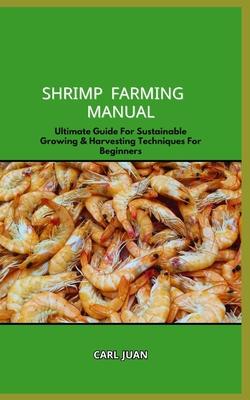
Book
Shrimp Farming Manual: Ultimate Guide For Sustainable Growing & Harvesting Techniques For Beginners
by Carl Juan
(Write a Review)
Unfortunately this title is no longer available
The following are the common steps involved in shrimp farming:
- Site selection refers to the process of determining a farm's future home, which is typically a coastline or brackish water environment.
- The process of preparing a pond or other enclosure for the purpose of raising shrimp. The water's temperature, salinity, and quality must be controlled.
- Choosing a healthy seed stock of shrimp entails sourcing larvae or juveniles (often referred to as "seed" or "post larvae") from breeding facilities.
- Nutrition and feeding entails giving the shrimp the food they need to thrive and controlling how much they eat.
- Managing water is keeping water in a suitable condition by controlling variables such as dissolved oxygen, pH, and salt concentration. It's critical to have adequate aeration and filtration systems.
- Management and prevention of disease using strategies like routine observation, isolation, and antibiotics.
- Growth and Harvesting: Monitoring the shrimp's growth and ensuring adequate conditions for development. When the shrimp have reached the appropriate size, they are harvested using nets or other devices.
- The term "processing and marketing" refers to the steps taken after a shrimp harvest to prepare the catch for sale to the general public.
Shrimp farming can be done on a wide range of scales, from backyard operations to multimillion-dollar corporations. Shrimp, a delicacy enjoyed in many cultures, has helped boost the worldwide fish business. There have been attempts to create more sustainable and environmentally responsible shrimp farming practices, such as integrated multi-trophic aquaculture (IMTA) and better farm management techniques, in response to issues with sustainability, environmental impact, and disease management.
The following are the common steps involved in shrimp farming:
- Site selection refers to the process of determining a farm's future home, which is typically a coastline or brackish water environment.
- The process of preparing a pond or other enclosure for the purpose of raising shrimp. The water's temperature, salinity, and quality must be controlled.
- Choosing a healthy seed stock of shrimp entails sourcing larvae or juveniles (often referred to as "seed" or "post larvae") from breeding facilities.
- Nutrition and feeding entails giving the shrimp the food they need to thrive and controlling how much they eat.
- Managing water is keeping water in a suitable condition by controlling variables such as dissolved oxygen, pH, and salt concentration. It's critical to have adequate aeration and filtration systems.
- Management and prevention of disease using strategies like routine observation, isolation, and antibiotics.
- Growth and Harvesting: Monitoring the shrimp's growth and ensuring adequate conditions for development. When the shrimp have reached the appropriate size, they are harvested using nets or other devices.
- The term "processing and marketing" refers to the steps taken after a shrimp harvest to prepare the catch for sale to the general public.
Shrimp farming can be done on a wide range of scales, from backyard operations to multimillion-dollar corporations. Shrimp, a delicacy enjoyed in many cultures, has helped boost the worldwide fish business. There have been attempts to create more sustainable and environmentally responsible shrimp farming practices, such as integrated multi-trophic aquaculture (IMTA) and better farm management techniques, in response to issues with sustainability, environmental impact, and disease management.
Paperback
$8.59